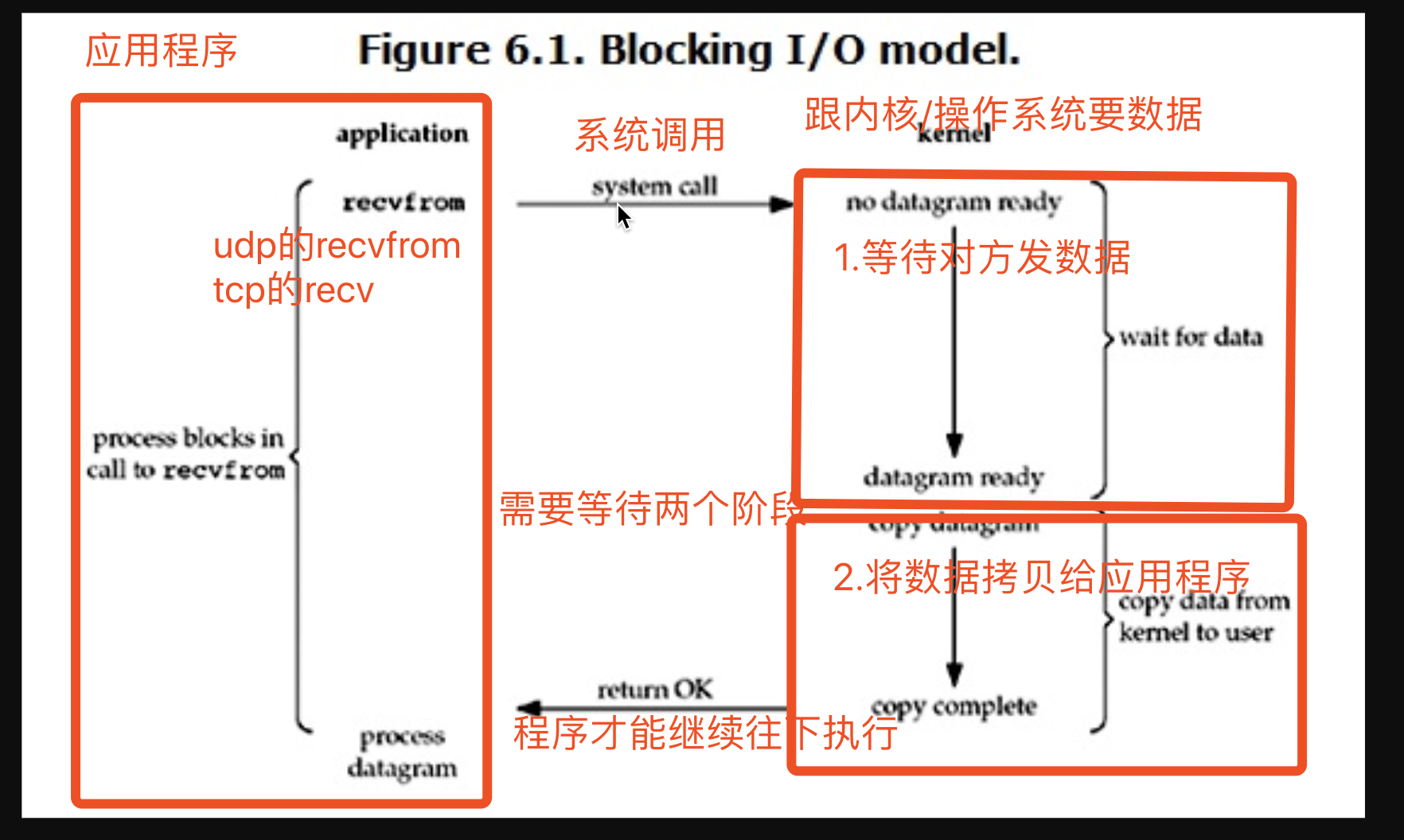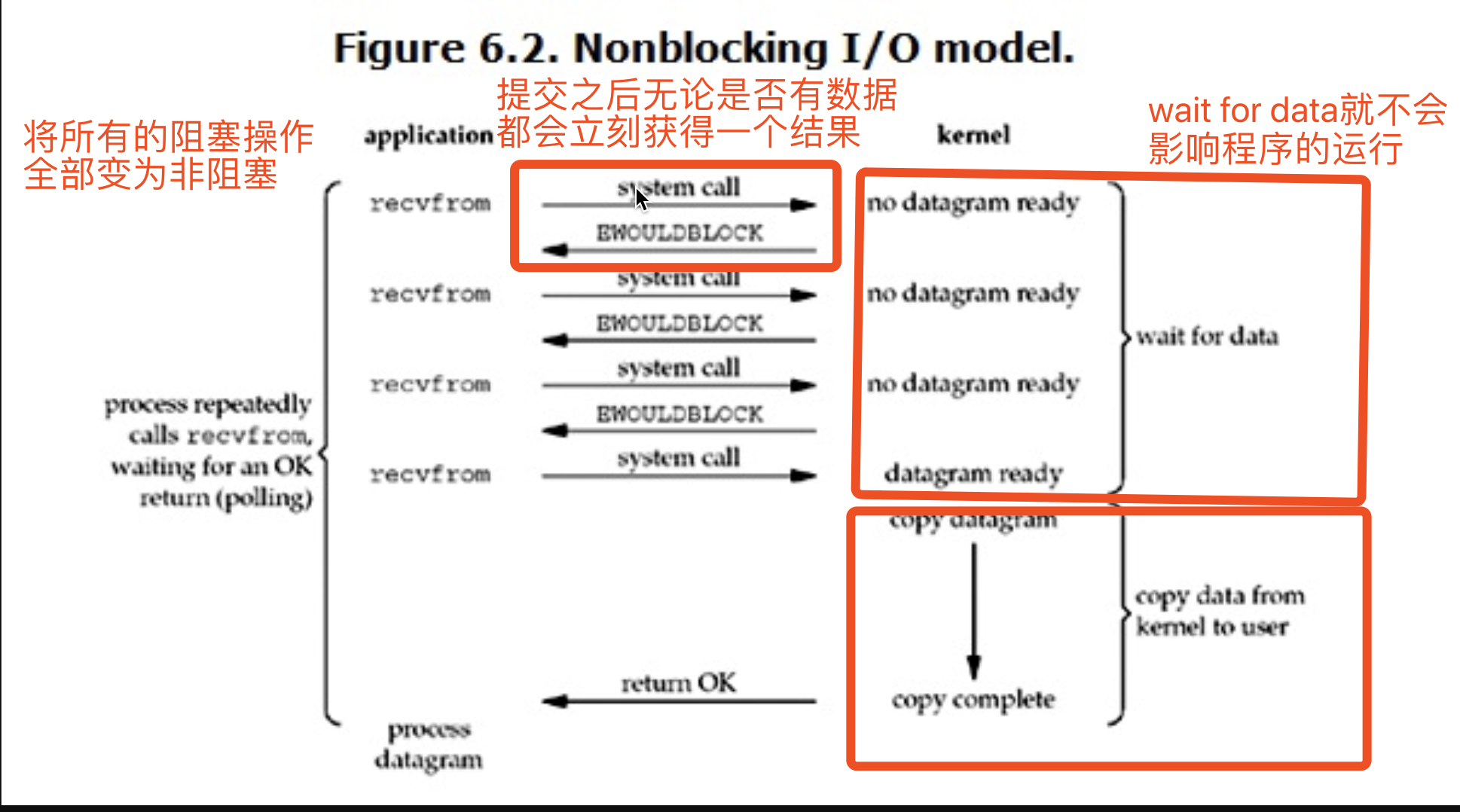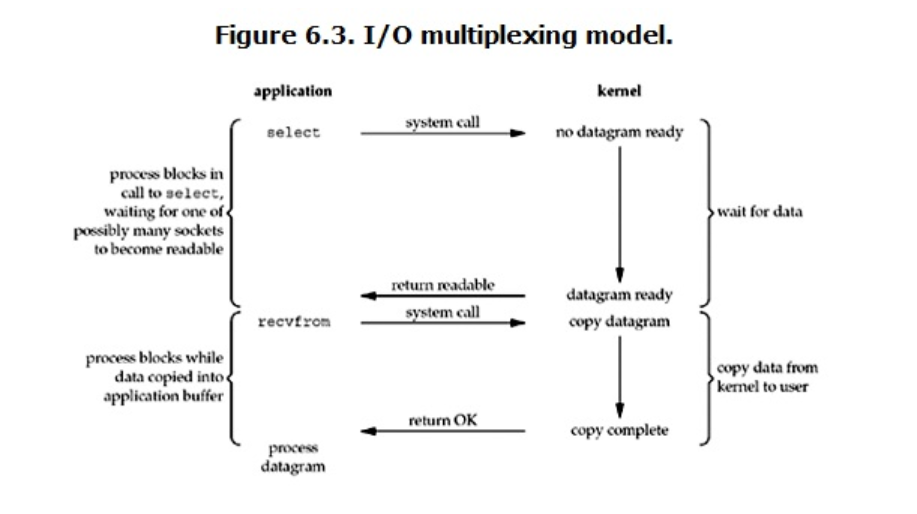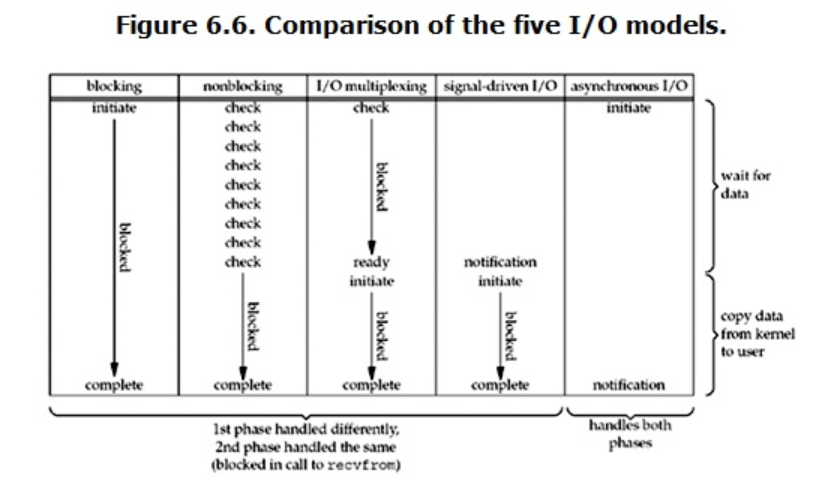IO模型
详细内容参考: https://www.cnblogs.com/Dominic-Ji/articles/10929396.html
IO模型简介
"""
我们这里研究的IO模型都是针对网络IO的
Stevens在文章中一共比较了五种IO Model:
* blocking IO 阻塞IO
* nonblocking IO 非阻塞IO
* IO multiplexing IO多路复用
* signal driven IO 信号驱动IO
* asynchronous IO 异步IO
由signal driven IO(信号驱动IO)在实际中并不常用,所以主要介绍其余四种IO Model。
"""
#1)等待数据准备 (Waiting for the data to be ready)
#2)将数据从内核拷贝到进程中(Copying the data from the kernel to the process)
同步异步
阻塞非阻塞
常见的网络阻塞状态:
accept
recv
recvfrom
send虽然它也有io行为 但是不在我们的考虑范围
阻塞IO模型

import socket
server = socket.socket()
server.bind(('127.0.0.1',8080))
server.listen(5)
while True:
conn, addr = server.accept()
while True:
try:
data = conn.recv(1024)
if len(data) == 0:break
print(data)
conn.send(data.upper())
except ConnectionResetError as e:
break
conn.close()
非阻塞IO

import socket
import time
server = socket.socket()
server.bind(('127.0.0.1', 8081))
server.listen(5)
server.setblocking(False)
# 将所有的网络阻塞变为非阻塞
r_list = []
del_list = []
while True:
try:
conn, addr = server.accept()
r_list.append(conn)
except BlockingIOError:
# time.sleep(0.1)
# print('列表的长度:',len(r_list))
# print('做其他事')
for conn in r_list:
try:
data = conn.recv(1024) # 没有消息 报错
if len(data) == 0: # 客户端断开链接
conn.close() # 关闭conn
# 将无用的conn从r_list删除
del_list.append(conn)
continue
conn.send(data.upper())
except BlockingIOError:
continue
except ConnectionResetError:
conn.close()
del_list.append(conn)
# 挥手无用的链接
for conn in del_list:
r_list.remove(conn)
del_list.clear()
# 客户端
import socket
client = socket.socket()
client.connect(('127.0.0.1',8081))
while True:
client.send(b'hello world')
data = client.recv(1024)
print(data)
总结
"""
虽然非阻塞IO给你的感觉非常的牛逼
但是该模型会 长时间占用着CPU并且不干活 让CPU不停的空转
我们实际应用中也不会考虑使用非阻塞IO模型
"""
IO多路复用

"""
当监管的对象只有一个的时候 其实IO多路复用连阻塞IO都比比不上!!!
但是IO多路复用可以一次性监管很多个对象
server = socket.socket()
conn,addr = server.accept()
监管机制是操作系统本身就有的 如果你想要用该监管机制(select)
需要你导入对应的select模块
"""
import socket
import select
server = socket.socket()
server.bind(('127.0.0.1',8080))
server.listen(5)
server.setblocking(False)
read_list = [server]
while True:
r_list, w_list, x_list = select.select(read_list, [], [])
"""
帮你监管
一旦有人来了 立刻给你返回对应的监管对象
"""
# print(res) # ([<socket.socket fd=3, family=AddressFamily.AF_INET, type=SocketKind.SOCK_STREAM, proto=0, laddr=('127.0.0.1', 8080)>], [], [])
# print(server)
# print(r_list)
for i in r_list: #
"""针对不同的对象做不同的处理"""
if i is server:
conn, addr = i.accept()
# 也应该添加到监管的队列中
read_list.append(conn)
else:
res = i.recv(1024)
if len(res) == 0:
i.close()
# 将无效的监管对象 移除
read_list.remove(i)
continue
print(res)
i.send(b'heiheiheiheihei')
# 客户端
import socket
client = socket.socket()
client.connect(('127.0.0.1',8080))
while True:
client.send(b'hello world')
data = client.recv(1024)
print(data)
总结
"""
监管机制其实有很多
select机制 windows linux都有
poll机制 只在linux有 poll和select都可以监管多个对象 但是poll监管的数量更多
上述select和poll机制其实都不是很完美 当监管的对象特别多的时候
可能会出现 极其大的延时响应
epoll机制 只在linux有
它给每一个监管对象都绑定一个回调机制
一旦有响应 回调机制立刻发起提醒
针对不同的操作系统还需要考虑不同检测机制 书写代码太多繁琐
有一个人能够根据你跑的平台的不同自动帮你选择对应的监管机制
selectors模块
"""
异步IO

"""
异步IO模型是所有模型中效率最高的 也是使用最广泛的
相关的模块和框架
模块:asyncio模块
异步框架:sanic tronado twisted
速度快!!!
"""
import threading
import asyncio
#3.5之前
@asyncio.coroutine
def hello():
print('hello world %s'%threading.current_thread())
yield from asyncio.sleep(1) # 换成真正的IO操作
print('hello world %s' % threading.current_thread())
loop = asyncio.get_event_loop()
tasks = [hello(),hello()]
loop.run_until_complete(asyncio.wait(tasks))
loop.close()
#新版本asyncio用法
import asyncio
async def main():
print('Hello ...')
await asyncio.sleep(1)
print('... World!')
# Python 3.7+
asyncio.run(main())
四个IO模型对比
